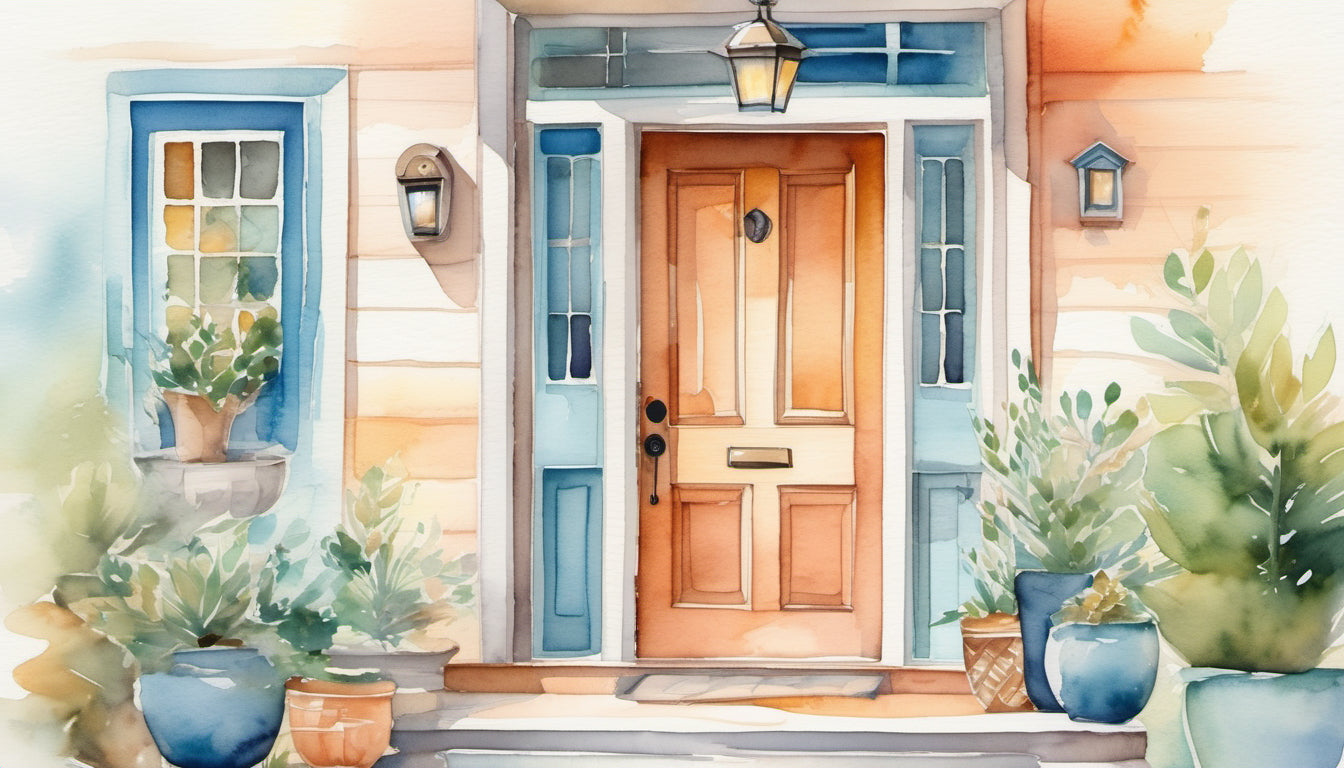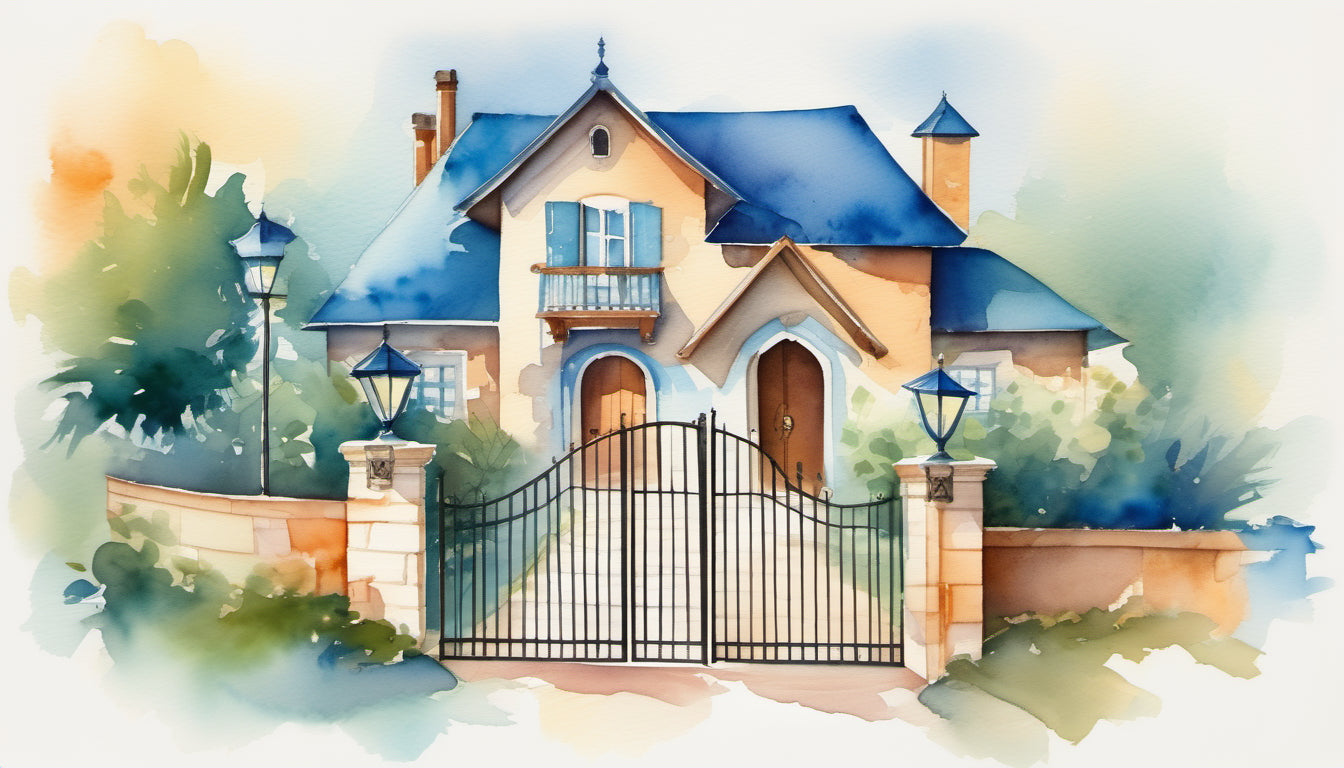Home is a place where we feel safe and secure, but unfortunately, it's also a target for burglaries and other security threats. Creating a secure home environment is essential for the well-being of your family and the protection of your belongings. In this article, we will explore essential home security measures that can help you safeguard your home and provide peace of mind.
Whether you live in a house or an apartment, taking steps to enhance the security of your home is crucial. From securing doors and windows to installing alarm systems and implementing home automation, there are several measures you can take to deter intruders and protect your property. We will discuss each of these measures in detail and provide useful tips for effective implementation.
Assessing your home's security needs is the first step towards creating a secure environment. By identifying vulnerable entry points, understanding your neighborhood's security risks, and determining your budget, you can tailor your security measures to suit your unique situation. We will delve into each of these considerations to help you make informed decisions.
Securing doors and windows is a fundamental aspect of home security. We will explore various techniques, such as installing quality deadbolt locks, adding reinforcement bars to doors, securing sliding glass doors, and using window locks and reinforcements. By implementing these measures, you can fortify your home and make it more difficult for intruders to gain access.
Installing an alarm system is another crucial step in enhancing home security. We will guide you through the process of choosing the right alarm system, positioning sensors and security cameras strategically, and integrating smart home technology for added convenience and protection. With a reliable alarm system in place, you can receive instant alerts and have peace of mind knowing that your home is constantly monitored.
Enhancing perimeter security is often overlooked but is equally important in deterring potential intruders. We will discuss the benefits of installing outdoor lighting, using fencing and gates effectively, and securing garages and sheds to create a strong security perimeter around your property.
Implementing home automation can significantly enhance the security and convenience of your home. We will explore how you can control lighting and appliances remotely, set up timers and motion sensors, and simulate occupancy with smart technology. With home automation, you can create the illusion of activity even when you're away, adding an extra layer of security.
Establishing neighborhood watch programs can be an excellent way to enhance security in your community. We will provide tips on getting to know your neighbors, organizing regular meetings, and sharing important security information. By working together, you and your neighbors can create a safer environment for everyone.
Safeguarding valuables and personal data is crucial in case of a break-in or other emergencies. We will discuss the importance of investing in a home safe, protecting important documents, and securing digital data. These measures can help you protect your valuable possessions and personal information from potential theft or damage.
By implementing these essential home security measures, you can create a safe and secure environment for you and your loved ones. Whether you live in a high-crime area or a peaceful neighborhood, it's important to be proactive and take steps to protect your property. So, let's dive into each section and discover the strategies that will help you create security in your home.
Assessing Your Home's Security Needs
When it comes to home security, it's important to assess your specific needs and vulnerabilities. By understanding the weak points in your home's security, you can take the necessary steps to protect your property and loved ones. Here are some key factors to consider when assessing your home's security needs:
Identifying Vulnerable Entry Points
The first step in securing your home is to identify the vulnerable entry points that could be potential targets for intruders. These can include:
- Doors: Check the condition of your exterior doors. Are they sturdy and secure? Pay attention to weak points such as loose hinges or damaged frames.
- Windows: Inspect your windows for any signs of weakness, such as broken locks or cracked glass.
- Garage doors: Make sure your garage doors are secure and have proper locking mechanisms.
Understanding Your Neighborhood's Security Risks
Every neighborhood has its own unique security risks, and it's important to be aware of them. Factors to consider include:
- Crime rates: Research the crime rates in your area to get an idea of the security risks you may face.
- Neighborhood watch: Find out if your neighborhood has an active neighborhood watch program. If not, consider starting one to promote safety and collaboration among neighbors.
- Location: Consider if your home is located in a secluded area or near a busy street, as these factors can influence the likelihood of break-ins.
Determining Your Budget
When it comes to home security, you don't have to break the bank to ensure your safety. It's essential to determine your budget and prioritize your security needs accordingly. Here are some cost-effective options to consider:
- DIY security: Many home security measures, such as installing security cameras or motion sensor lights, can be done yourself at a lower cost.
- Window and door reinforcements: Strengthening your windows and doors can be a budget-friendly way to enhance security.
- Home security systems: Evaluate different home security system options to find one that fits your budget. Remember, a reliable system doesn't necessarily have to be expensive.
By carefully assessing your home's security needs, you can develop an effective plan to safeguard your property. Whether it's reinforcing entry points, installing an alarm system, or investing in home automation, taking the time to evaluate your security requirements will help you make informed decisions and ensure peace of mind.
Securing Doors and Windows
When it comes to securing your home, one of the first areas to focus on is the doors and windows. This is because they are the most common entry points for burglars. By taking some simple yet effective measures, you can greatly enhance the security of your doors and windows. Here are some essential steps you can take:
Installing Quality Deadbolt Locks
Investing in high-quality deadbolt locks is one of the best ways to secure your doors. Deadbolts provide an extra layer of protection because they have a solid metal bolt that extends deep into the door frame. When choosing deadbolt locks, look for the following features:
- Solid construction: Opt for deadbolts made of sturdy materials like solid brass or steel. Avoid locks made of weak materials that can be easily compromised.
- Grade 1 security rating: Look for deadbolts with a grade 1 rating from the American National Standards Institute (ANSI). These locks offer the highest level of security.
- Key control: Choose locks with restricted keyways that prevent unauthorized key duplication.
Adding Reinforcement Bars to Doors
Reinforcement bars, also known as strike plates or door jammers, are metal plates that reinforce the area around the door's strike plate, where the bolt of a lock engages. These bars make it much more difficult for intruders to kick in the door or force it open. When adding reinforcement bars, consider the following points:
- Material: Opt for reinforcement bars made of heavy-duty steel for maximum strength.
- Length: Choose bars that are long enough to span the entire length of the strike plate for optimal protection.
- Installation: Follow the manufacturer's instructions carefully to ensure proper installation.
Securing Sliding Glass Doors
Sliding glass doors are a popular entry point for burglars because they often have weaker locks and can be easily forced open. To secure your sliding glass doors, consider the following options:
- Install a bar or rod: Place a metal or wooden bar in the track of the sliding door to prevent it from being lifted or forced open.
- Apply a window film: Window films can make it difficult for intruders to break the glass. Look for films designed to provide added security and shatter resistance.
- Upgrade the locks: Consider installing a secondary lock or a reinforced lock specifically designed for sliding glass doors.
Using Window Locks and Reinforcements
Windows are another vulnerable point of entry for burglars. Here are some ways to secure your windows effectively:
- Window locks: Install window locks on all your windows to prevent them from being easily opened from the outside.
- Window reinforcements: Consider adding window reinforcements, such as window bars, security film, or laminated glass, to strengthen the windows and make them more resistant to break-ins.
- Window sensors: Install window sensors connected to your alarm system to alert you if a window is opened or broken.
By taking these measures to secure your doors and windows, you can significantly increase the overall security of your home. Remember to evaluate the specific needs of your home and choose the solutions that best fit your budget and lifestyle. Stay tuned for more essential home security measures in the following sections!
Installing an Alarm System
When it comes to securing your home, installing an alarm system is a vital step in protecting your property and loved ones. An alarm system can serve as a deterrent to potential intruders and provide you with early warning in case of a break-in. Here are some key considerations to keep in mind when installing an alarm system:
Choosing the Right Alarm System
There are several types of alarm systems available on the market, each with its own features and benefits. Here are a few popular options to consider:
- Wireless Alarm Systems: These systems are easy to install and can be controlled remotely using your smartphone or computer. They are also less susceptible to tampering since there are no visible wires that can be cut.
- Wired Alarm Systems: These systems are more traditional and require professional installation. They are generally more reliable but may be more expensive due to the installation costs.
- Smart Home Security Systems: These systems integrate with other elements of your smart home, such as thermostats, lighting, and cameras, allowing you to control your security system remotely and receive notifications on your devices.
Consider the size and layout of your home, your budget, and your specific security needs when choosing an alarm system that is right for you.
Positioning Sensors and Security Cameras
Proper placement of sensors and security cameras is essential for an effective alarm system. Here are some guidelines for optimal positioning:
- Door and Window Sensors: Install sensors on every accessible door and window, paying particular attention to ground-level entry points. Ensure that the sensors are securely placed and aligned for accurate detection.
- Motion Sensors: Position motion sensors in strategic areas, such as hallways and rooms with valuable items. Aim to cover key areas without creating false alarms from pets or regular movement.
- Security Cameras: Place security cameras at vulnerable spots, such as the front door, back entrance, or garage. Ensure the cameras have a wide field of view and are positioned high enough to prevent tampering.
Regularly test your alarm system to ensure the sensors and cameras are working properly and make any necessary adjustments.
Integrating Smart Home Technology
In today's increasingly connected world, integrating your alarm system with smart home technology can provide added convenience and control. Here are some ways to enhance your security system with smart home features:
- Mobile Alerts: Receive instant notifications on your smartphone or tablet when your alarm is triggered. This allows you to take immediate action, such as contacting authorities or checking your surveillance cameras remotely.
- Home Automation Integration: Integrate your alarm system with other smart home devices, such as lights and door locks. This allows you to create automated routines that simulate occupancy when you're away, deterring potential intruders.
- Voice Control: Connect your alarm system to voice-activated assistants like Amazon Alexa or Google Assistant to arm and disarm your system using voice commands.
By incorporating these smart features, you can enhance the effectiveness and convenience of your alarm system.
Remember, installing an alarm system is just one part of a comprehensive home security plan. It's important to also secure entry points, enhance perimeter security, and consider other safety measures. By taking a holistic approach to home security, you can create a safe and secure environment for you and your family.
Enhancing Perimeter Security
When it comes to home security, it's crucial to consider not only the interior of your home but also the exterior. By enhancing perimeter security, you can effectively deter potential intruders and protect your property. Here are some essential measures you can take to enhance perimeter security:
Installing Outdoor Lighting
A well-lit exterior can make a significant difference in deterring burglars. By illuminating your property, you eliminate shadows and make it more challenging for someone to approach your home unnoticed. Consider the following tips for outdoor lighting:
- Install motion-activated lights around your driveway, walkways, and entry points. These lights will only turn on when they detect movement, creating a sudden burst of light that can startle and discourage potential intruders.
- Use energy-efficient LED lights that not only save electricity but also produce a brighter and more focused light.
- Ensure that all entrances, including side doors and backyards, have adequate lighting. This will make it harder for burglars to find hiding spots.
Using Fencing and Gates
A sturdy fence can act as a physical barrier and deter unauthorized access to your property. Here's how you can make the most of your fencing:
- Choose a fence that is difficult to climb. Opt for materials like wrought iron or chain-link with sharp pickets at the top.
- Make sure your gate is secure and has a reliable locking mechanism. Consider installing a keypad or keyless entry system for added convenience and security.
- Trim any trees or hedges near your fence, as they can provide cover for potential intruders.
Securing Garages and Sheds
Don't overlook the security of your garages and sheds, as they often contain valuable items and tools. Consider the following steps to secure these areas:
- Install a strong, high-quality lock on your garage door. Consider using a deadbolt lock or a lock with a keyless entry system.
- Cover garage windows or use frosted glass to prevent potential intruders from seeing what's inside.
- Store valuable tools and equipment in locked cabinets or secure them with heavy-duty chains and locks.
- Install an alarm system that includes sensors for your garage or shed doors.
Enhancing perimeter security creates an additional layer of protection for your home. By implementing these measures, you can significantly reduce the risk of burglary and keep your property and loved ones safe.
Remember, preventative measures are key to home security, and taking action to enhance the security of your home's perimeter is a proactive step towards creating a safe environment for you and your family.
Implementing Home Automation
Home automation is becoming increasingly popular as homeowners seek ways to make their lives easier and more comfortable. But did you know that implementing home automation can also enhance the security of your home? By integrating smart technology into your security measures, you can take your home's safety to the next level. In this section, we will explore how you can use home automation to safeguard your property and loved ones.
Controlling Lighting and Appliances Remotely
One of the key benefits of home automation is the ability to control lighting and appliances remotely. This means that even when you're away from home, you can create the illusion that someone is there, deterring potential burglars. Here's how you can do it:
- Install smart light bulbs and plugs that can be controlled through a mobile app. You can schedule lights to turn on and off at specific times or control them manually from anywhere in the world.
- Connect your lamps, TVs, and other devices to smart plugs. This allows you to turn them on and off remotely or set them on a timer, giving the appearance of an occupied home.
- Use motion sensors to automatically turn on lights when someone enters a room. This not only adds convenience but also acts as a deterrent by implying that someone is home.
Setting Up Timers and Motion Sensors
Aside from controlling lighting and appliances remotely, you can also enhance home security by setting up timers and motion sensors. These features are especially effective at making your home appear occupied even when it's not. Here's how you can leverage them:
- Use timers for your curtains or blinds to open and close at specific times, giving the impression that someone is at home and following a daily routine.
- Install motion sensors both inside and outside your home. When someone approaches, the sensors will trigger lights to turn on, making it harder for intruders to remain undetected.
Simulating Occupancy with Smart Technology
One of the most significant advantages of home automation is the ability to simulate occupancy. By utilizing smart technology, you can create the illusion that your home is occupied, even when you're away. Here's how you can achieve this:
- Program your smart lighting system to mimic your daily routines. For example, you can set lights to turn on in the morning, dim in the evening, and switch off at bedtime.
- Connect your TV to a smart plug and schedule it to turn on during your usual viewing hours. This can help create the impression that someone is at home, enjoying their favorite shows.
By implementing home automation, you can enhance the security of your property while adding convenience to your life. Whether you're at work or on vacation, you can have peace of mind knowing that you have full control over your home's lighting and appliances. Additionally, by simulating occupancy, you can deter potential burglars and keep your home safe.
In the next section, we will explore the importance of establishing neighborhood watch programs and how they can contribute to creating a safe community. Stay tuned!
Next Section: Establishing Neighborhood Watch Programs
Establishing Neighborhood Watch Programs
Your neighborhood is more than just a collection of houses; it's a community. And what better way to foster a sense of safety and security within your community than by establishing a neighborhood watch program? By working together with your neighbors, you can create a safer environment for everyone. In this section, we'll explore the steps you can take to set up and maintain a successful neighborhood watch program.
Getting to Know Neighbors
The first step in establishing a neighborhood watch program is getting to know your neighbors. Building relationships and fostering a sense of camaraderie is key to the success of your program. By establishing a strong foundation of trust and communication, you can work together more effectively to keep your neighborhood safe.
- Host a neighborhood gathering: Consider organizing a block party or a meet-and-greet event where neighbors can socialize and get to know each other. This is a great opportunity to discuss the idea of starting a neighborhood watch program and gauge interest.
- Exchange contact information: Create a neighborhood directory with contact information for each household. This can help neighbors stay in touch and quickly alert each other about any suspicious activities or emergencies.
Organizing Regular Meetings
Regular meetings are essential for building a strong neighborhood watch program. These meetings allow neighbors to discuss any concerns, share information, and plan strategies to address security issues. Here are some tips for organizing successful meetings:
- Set a regular schedule: Determine a convenient time and place for meetings, and stick to a consistent schedule. This will ensure that everyone has the opportunity to attend and participate.
- Invite local law enforcement: Reach out to your local police department or community resource officer and invite them to attend your meetings. They can provide valuable insights, offer guidance, and answer any questions you may have.
- Create an agenda: Prepare an agenda for each meeting to keep discussions focused and productive. Include items such as reviewing recent incidents, sharing updates on security measures, and planning community initiatives.
Sharing Important Security Information
Communication is crucial in a neighborhood watch program. By sharing important security information with your neighbors, you can help everyone stay informed and vigilant. Here are some ways to effectively share information within your community:
- Establish a communication channel: Create a group chat or email list where neighbors can share information about suspicious activities, security tips, and relevant news. This allows for quick and efficient communication among members.
- Distribute informative materials: Provide your neighbors with brochures or flyers that outline essential security measures, such as locking doors and windows, reporting suspicious behavior, and emergency contact information. These materials serve as helpful reminders and educational resources.
- Utilize social media: Consider creating a neighborhood watch group on social media platforms like Facebook or Nextdoor. This platform can facilitate discussions, share updates, and even organize community events.
Establishing a neighborhood watch program takes effort and commitment from everyone involved, but the benefits are undeniable. By working together, you can enhance the safety and security of your neighborhood and create a stronger sense of community. Remember, an informed and engaged community is the first line of defense against crime.
Now that you have a better understanding of how to establish a neighborhood watch program, let's move on to the next section, where we'll explore the importance of safeguarding your valuables and personal data.
Safeguarding Valuables and Personal Data
When it comes to home security, it's not just about protecting your physical space and loved ones. It's also about safeguarding your valuables and personal data from potential theft or loss. In this section, we'll discuss some essential measures you can take to ensure the safety of your belongings and sensitive information.
Investing in a Home Safe
A home safe is a smart investment that can provide an extra layer of protection for your valuable items. Consider purchasing a high-quality safe that is both fireproof and waterproof. Here are some tips to keep in mind when choosing a home safe:
- Size: Determine the size you need based on the items you plan to store. It should be spacious enough to accommodate important documents, jewelry, cash, and other small valuables.
- Locking mechanism: Look for safes with secure locking mechanisms such as digital locks, biometric locks, or combination locks.
- Mounting options: Consider whether you want to mount the safe to the floor or wall for added security.
- Insurance rating: Check for safes with insurance ratings that meet your requirements. This can help ensure that your belongings are covered in case of theft or damage.
Protecting Important Documents
In addition to your valuables, you should also take steps to protect important documents such as passports, birth certificates, property deeds, and financial records. Here are some measures to consider:
- Secure storage: Keep your important documents in a fireproof and waterproof document bag or folder. Alternatively, you can store them in sealed plastic bags within your home safe.
- Duplicate copies: Create duplicate copies of essential documents and store them in a separate location, such as a safety deposit box or with a trusted family member.
- Digital backups: Scan important documents and store digital copies on a secure external hard drive or in a cloud-based storage service. Ensure that your digital storage is password protected and encrypted.
Securing Digital Data
In today's digital age, protecting your personal data is just as crucial as safeguarding your physical belongings. Here are some steps you can take to enhance the security of your digital information:
- Strong passwords: Use strong, unique passwords for all your online accounts. Include a combination of uppercase and lowercase letters, numbers, and special characters. Avoid using easily guessable information like birthdays or names.
- Two-factor authentication (2FA): Enable 2FA whenever possible to add an extra layer of security to your online accounts. This typically involves entering a temporary code sent to your mobile device in addition to your password.
- Regular updates: Keep your devices and software up to date with the latest security patches and updates. This helps protect against vulnerabilities that hackers may exploit.
- Firewall and antivirus software: Install a reliable firewall and antivirus software on your devices to detect and prevent malware and other malicious activities.
- Secure Wi-Fi network: Set up a strong password for your Wi-Fi network to prevent unauthorized access to your internet connection and devices.
By following these tips, you can significantly enhance the security of your valuables and personal data. Remember that home security is a multi-faceted approach, so it's essential to implement a combination of measures tailored to your specific needs and circumstances.
Conclusion
In conclusion, creating security in your home is of utmost importance to ensure the safety and well-being of you and your loved ones. By taking the necessary steps to assess your home's security needs, secure doors and windows, install an alarm system, enhance perimeter security, implement home automation, and establish neighborhood watch programs, you can greatly reduce the risk of any security breaches. Additionally, safeguarding your valuables and personal data will provide you with peace of mind.
Remember, a secure home is a happy home. Take the time to evaluate your current security measures and make the necessary improvements to protect your home and those within it.
Empowered by Ashley is here to help you with your personal safety needs. Our best-selling product, the Personal Safety Alarm, is designed to deter attackers and provide you with a sense of security. To learn more about our products and how they can benefit you, visit our website at empoweredbyashley.com.
Stay protected, stay empowered!
Frequently Asked Questions
-
What are some essential home security measures?
Some essential home security measures include: installing sturdy doors and windows, using deadbolt locks, installing a security system, using outdoor lighting, securing sliding doors and windows, and keeping your property well-maintained and free of hiding spots for burglars.
-
Should I invest in a home security system?
Investing in a home security system is highly recommended, as it provides round-the-clock monitoring, alarm notifications, and surveillance footage, which can deter criminals and provide evidence in case of a break-in.
-
Do I need to update my locks?
Yes, it's important to regularly update your locks to ensure the highest level of home security. Consider upgrading to deadbolt locks or smart locks, which offer enhanced protection against forced entry.
-
How can outdoor lighting improve home security?
Outdoor lighting can deter potential intruders by eliminating dark areas around your home. Install motion-sensor lights near entrances, pathways, and vulnerable spots to increase visibility and discourage burglars.
-
What should I do to secure sliding doors and windows?
To secure sliding doors and windows, you can use window security film, install track locks or bars, add a security pin to prevent lifting, or place a wooden dowel in the track to prevent sliding. Reinforcing glass with laminated or tempered glass is also recommended.




















Leave a comment
This site is protected by hCaptcha and the hCaptcha Privacy Policy and Terms of Service apply.